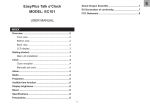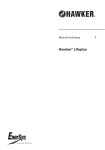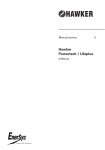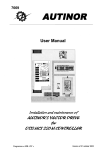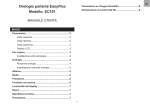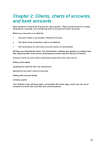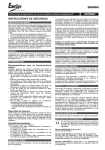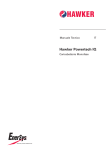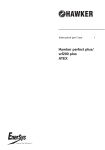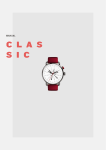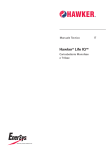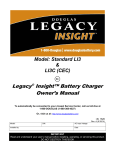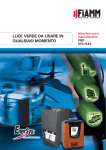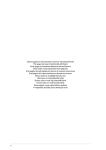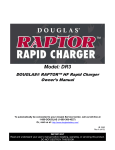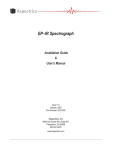Download 14829 TH Lifespeed gb - EnerSys
Transcript
Technical Manual GB Hawker Lifespeed 3000 quis nostrud exerci tation ullamcorper suscipit lobortis nisl ut aliquip Model ATR 3015 Model ATR ATR 3015 ENGLISH Contents Information Summary...................................................................................... 3 Goals of this manual Information.................................................................................. 3 Goals of this manual................................................................................. This manual is aimed at any authorized personnel wanting to use a three phase Lifespeed 3000 Series charger to recharge lead acid type industrial batteries. This manual contains information on: • Charger functionality. • Use and setting of charger parameters. • Technical specifications of the Lifespeed 3000 chargers. Hawker intends to provide clear and simple information in this manual. Hawker assumes no responsibility for misunderstanding or improper interpretation of the information. The owner of the equipment is required to preserve this manual for the life of the equipment and to transfer said manual to any subsequent purchaser. 3 Warranty..................................................................................................... 3 Recommendations..................................................................................... 3 Electrical safety.......................................................................................... 3 Product recycling........................................................................................ 4 Modifications and improvements............................................................. 4 Warranty Receiving - Storage.................................................................................... 4 Warranty is offered by the manufacturer based on local regulations. Please contact your local distributor for further information. Replacement parts...................................................................................... 4 Information plate........................................................................................ 4 Recommendations Glossary...................................................................................................... 4 Recommendations for safe operation EEC declaration of conformity.................................................................. 4 This manual should be carefully read, prior to using the equipment, by anyone intending to use the charger. The Lifespeed 3000 charger: The Charger.................................................................................. 5 • Never disconnect a battery from the charger if in operation. Either • allow the charger to terminate automatically or turn charger off prior to disconnecting. • This charger comes equipped with an anti-arcing connector. Any battery used on this charger must be equipped with a matching connector, and its auxiliary input wire must be connected to battery positive (B+). Failure to make this connection will prevent the charger from operating. • The charger must not have its air circulation impaired in any way, primarily around the air inlet areas. Dust accumulation must be removed every six months • The charger must be used within its protection norms, and never be directly in contact with water. • The charger must be used only within the temperature range specified in the technical specifications. • The charger must not be installed on a surface subject to high vibration levels (proximity of motors, compressors, etc.). Introduction................................................................................................ 5 External components................................................................................. 5 Control panel.............................................................................................. 5 The Menus.................................................................................... 6 Access to the menus................................................................................. 6 Memorized data......................................................................................... 6 Status.......................................................................................................... 7 Configuration.............................................................................................. 7 Contrast....................................................................................................... 7 Battery configuration Backlight...................................................................................................... 7 Using the Charger........................................................................ 8 This charger is designed to be used with a Fast charge adapted battery. Only batteries equipped with: • An easyplus device with appropriate configuration • Specific defined connectors in accordance with charging rates. • Specific harness and battery plug equipped with auxiliary contacts. may be used with this charger. Unpacking................................................................................................... 8 Operator safety Mechanical installation.............................................................................. 8 All proper precautions must be observed when the equipment is used in areas where accidents are possible. Insure proper ventilation when the charger is used with lead-acid batteries. Do not disconnect the battery while the Lifespeed 3000 is charging. Date / Time.................................................................................................. 7 Language..................................................................................................... 7 Electrical connections................................................................................ 8 Factory setup.............................................................................................. 8 General warnings Charging the battery.................................................................................. 8 Requirements for use: • The equipment must be properly grounded. • The input voltage must match the charger requirements. • The battery voltage must match the charger’s capabilities. • The battery capacity is within the charger’s range. Historical data per charge......................................................................... 9 Charger’s historical data............................................................................ 9 Fault codes.................................................................................................. 9 Electrical safety Safety regulations and requirements must be observed. Safety devices installed ahead of the chargers must be of the proper type and rating. It is important to ensure that only fuses of the proper capacity be used, should they need to be replaced. This charger meets the Class 1 Electrical Safety requirements, and therefore needs to be properly grounded during installation. It must be connected to a power supply equipped with a ground cable, and the ground connection should be as short as possible. The equipment must be totally disconnected from all power sources (grid and battery) before it can be opened for inspection or servicing. The battery can only be disconnected after the main ON/OFF switch has been pushed to the OFF position. Access to the inside of the charger should be restricted to authorized maintenance personnel. 3 Please consult a qualified factory representative about any problems or questions related to the installation of this unit. This charger is designed to be used in a sheltered area. It is meant exclusively to recharge lead batteries in an industrial environment. If the battery temperature, communicated by the easyplus, is too high, the charger, before to start the charge, will switch on the air pump to cool down the battery. During this time the charger will display the message ‘TEMP’. When the battery temperature is gone down to a specific threshold the charger starts the charge. No risk for the battery, the charger will switch automatically to the Ionic profile if there are a fault on the air pressure or no communication with the easyplus. Complete recharging of the battery is done in short time, while energy consumption is substantially reduced. Product recycling When this charger becomes obsolete, it can be recycled by authorized recycling facilities. Local regulations will prevail and must be followed. Modifications and improvements Ionic profile Also called “Ionic Mixing” this profile consists of applying short current pulses to the battery, thus provoking gassing in the active material to diffuse the sulphuric acid off of the plates. This introduction of Ionic Mixing permits a faster charging of the battery and eliminates the differences in density by homogenizing the electrolyte throughout the cells. The ionic profile is not high speed and requires standard recharge times. Hawker reserves the right, at any time, to modify or improve its products, without any obligation to update this product or this manual accordingly. Receiving - Storage Upon reception, please inspect visually the exterior of the charger for any possible damages. If necessary, proceed within 24 hours with the usual claims with the transport company. If the charger is to be stored before use, it should remain in the original packaging, carefully closed. Store in a clean, dry area at a moderate temperature (0 °C to +40 °C). If the equipment is stored at a temperature below 15°C, it must be gradually restored to operating temperature before use, to prevent the risk of condensation that could cause electrical faults and short-circuits. EEC declaration of conformity Hawker hereby declares that the chargers in the Lifespeed ranges covered by this declaration conform to the descriptions laid down in European Directives 89/336/EEC, 93/68/EEC and RoHS 2002/96/EEC. Replacement parts Please supply the unit’s serial number, indicated on the information plate when ordering any replacement parts. Information plate Located on either side of the charger. Glossary Charger Features The Lifespeed 3000 Series chargers are managed by a micro-processor. The micro-processor reads the battery capacity from the easyplus and sets the charge current appropriately. This allows the charger to work over a wide range of battery capacity. Charge factor Charge factor is the quantity of Ampere Hours returned to the battery during the charge cycle versus the amount removed during the last discharge. Refresh Charge A refresh charge maintains the battery at the optimum level as long as it is connected to the charger. Desulphation charge A desulphation charge is done prior to normal charging, and this charge restores the specific gravity of overly discharged or underused batteries. Equalization charge Done after the normal charge, it balances out the various cells. Hawker easyplus The easyplus is permanently mounted to the battery and communicates to the charger without the need for extra wires. Battery parameters necessary for the optimization of the charging process are communicated to the charger via the easyplus. The easyplus has an electrolyte level sensor. Charging profile Defines the profile of the current applied to the battery during charging, in relation to available time. The charger, coupled with easyplus, adapts to the battery based on capacity and state of charge in order to maximize overall battery life. High Speed profile Utilizing a specific patented algorithm, the electronic circuits of the Lifespeed 3000 charger reduce the natural resistance of the battery by introducing, at precise intervals, discharge cycles into the charging profile. This homogenization of the ions around the plates allows for a better distribution of the active ions in the charging zones. A substantially larger current can therefore be applied and sustained, resulting in a much faster charging process, while maintaining full temperature control during the charge. 4 The Charger Introduction Control panel The Lifespeed 3000 series of chargers are compatible with batteries at 24, 36, 48 and 80 volts (depending on the version supplied). Battery recognition (voltage, capacity, state of charge, age, etc..) is accomplished by communication from the easyplus. Battery management is optimized through use of the easyplus. Two charging profiles are available (High Speed or IONIC) based on the configuration chosen by the operator. Furthermore, desulphation, equalization and compensation charges are integrated. Incorporates the Display and Control Panel. Please refer to The Menus (page 6) and Using the charger (page 8) for further details and features. External components 1 1 2 3 3 4 4 5 6 5 2 quis nostrud exerci tation ullamcorper suscipit lobortis nisl ut aliquip 7 Model ATR ATR 3015 4 Ref. Function 1. Graphical LCD Display. 2. Navigation button (UP) 3. Accept / Select button. 4. Navigation button (DOWN) 5. RED fault indicator. OFF: no fault. 6 1 Flashing: ongoing fault detected. ON: fault. 6. YELLLOW charging indicator. OFF : charger is off. ON : charging in progress. Figure 1: Principal components of the wall and floor mounted Lifespeed 3000 series charger models 7. GREEN end of charge indicator. OFF : charger off or battery not available Flashing : cooling phase. ON : battery ready and available. 1 2 8. ON / OFF switch 9. Menu exit, equalization start or desulphation start button. Figure 2: Charger Display and Control components 6 Model ATR 3015 Ref. Function 1. Ventilation fins. 2. Display and Control panel (see fig. 2). 3. AC Input cable. 4. Hood retaining screw. 5. Wall mount. 6. Battery cables. 5 The Menus The Menus provide access to the following functions : • Last 100 charging profiles (MEMORIZATIONS menu). • Viewing of faults, alarms, etc.. (STATUS menu). • Charger configuration (CONFIGURATION menu). • Contrast adjustment (CONTRAST menu), backlighting of the display (BACKLIGHT menu), date and time (DATE/TIME menu), language (LANGUAGE menu) and display format (REGION menu). Ref. Information 1. Battery serial number. 2. Voltage, capacity & recorded temperature prior to charging. 3. Detected profile. 4. Alarm Icon (see Table A). Icons Alarms Access to the menus ! Button functionality The pads provide the following functions : Alarms present. Low electrolyte level. Uneven battery voltage. Pad Function ▼▲ Navigation within the menu. Missed equalization cycles. OK Select active menu or Select highlighted value. Excessive overdischarge. Close the window / Cancel. Excessive daily cycles. C Excessive temperature. easyplus disconnection. Table A: Alarm icons. MENU80 V– 85A SMT MEMORISATIONS STATUS CONFIGURATION CONTRAST BACKLIGHT DATE /TIME V3 . 3 Screen #2 (charger information) SMT 80MEMO V– 85A 1 Each of the eight available menus is described below (the last menu lines LANGUAGE and REGION are only visible after pressing the ▼). V3 . 3 IONIC 2. 33 3Ah 47 % 30°C 2. 40V/26A 00 : 07 DF5 CFC=0x0100C802 1 2 3 4 5 Escape a Menu The active menu is automatically cancelled after one minute of inactivity or by pressing . Ref. Memorized data 1 Displays historical data from the last 100 charge cycles. Information Type, state of charge and temperature recorded prior to the charge. 2 Access Voltage per cell before and after charging, and current at termination of charge. From the main menu select MEMORIZATIONS and press OK. The List screen 3 Capacity restored and total charging time (format hr:min). 4 End of charge condition icon : Normal. The sample screen below indicates that 17 records exist (title line). MEMO 1 refers to the latest record. After the 100th record is memorized, the oldest will be replaced automatically. MEMORISATIONS SMT 80 V– 85A MEMO 1 MEMO 2 MEMO 3 MEMO 4 MEMO 5 MEMO 6 Normal with interruption (voluntary or caused by a fault). Type and time of fault (see Fault Codes, page 9). 5 (17) V3 . 3 Coded end of charge indicator. Screen #3 (connection, disconnection) MEMO MEMO 1 1 2 3 4 To view a charge history Proceed as follow: 1. 2. 3. 4. 5. Select a record (MEMO x) by pressing ▼ or ▲. View the first screen by pressing OK. View the second screen by pressing ▼. View the third screen by pressing again on ▼. Return to the main menu by pressing . Displayed information The charge profile history is displayed on three screens. Screen #1 (battery information) 17/06/2005 14:17 Ref. Information 1. Battery connected symbol. 2. Time and date of battery connection. 3. Battery disconnection symbol. 4. Time and date of battery disconnection. Reset of displayed information Resetting the information displayed on these three screens is done by pressing the Reset command from the CONFIGURATION menu (see page 7). MEMO MEMO 1 1 2 3 4 16/06/2005 16:41 CA11402 48V 500Ah 30°C IONIC ! 6 For example, choosing Monday will start the equalization process every Monday, based on a duration and delay programmed under Equalization Time and Equalization Delay. The equalization can be started automatically or manually. See paragraph End of Charge with Equalization on page 9. Status This menu displays the charger’s internal counters (number of normal charges, of equalization charges, faults by type, etc..) Access Delayed Charge From the main menu select STATUS and press OK. Two way to set a delay charge: • Defines a delay between 0 and 8 hours between the time that the battery is connected, and the actual start of the charging process. • Defines an hour to start the charge (hh:mm), if the battery is connected to the charger the charge will start at the program hour. Allows for charging during “Off peak” periods. The Screen Information is displayed on one screen. As an example: Battery Rest STATUS SMT 80 V– 85A CHARGE 20 6 14 EQUAL 5 TH 0 DF1 0 V3 . 3 DF2 0 DF3 0 DF4 0 DF5 0 DF7 1 DF8 0 DF9 0 Defines a waiting period from 0 to 8 hours after the end of the charge to allow the battery to cool off. Cable Length Length of battery cable from the connector to positive post of battery. Acceptable range is from 1 to 10 meters. The above display corresponds to the following data: This parameter is very important as it directly affects characteristics of the charging profile. Indication Information Charge Cable Section Total number of charges. Corresponds to the total of Determines the cross-section of the battery cables in mm2. Select a section from the list displayed. If different sizes are being used on the battery and the charger, enter the smaller of the two. normally terminated charges and charges terminated with or by faults. Number of charges terminated abnormally. This parameter is very important as it directly affects characteristics of the charging profile. Number of charges normally terminated. EGAL Reset Number of equalization charges completed by the charger. TH Number of temperature faults*. DF1 etc. Number of faults recorded by the charger (see Fault Resets the counters in Status and Memorized Data after you put in the password; this password is different than the one used to enter into Configuration. Version config Codes on page 9). Shows the charger’s configuration version. Reset of displayed information Resetting the information displayed on these three screens is done by pressing the Reset command from the CONFIGURATION menu. Contrast Modifies the display contrast level. A value of 0 displays a white screen ; a value of 100 displays a black screen. Configuration This menu leads to the ten charger configuration menus. The optimum value varies with ambient light. If you cannot read the screen (screen black or white): 1. Press and hold and ▲ at the same time. 2. When the LEDs start flashing (Fig. 2), adjust the contrast with the ▼ or ▲ pads. 3. Confirm by pressing OK. Access With the charger at rest (main switch on « 0 »), press OK. On the first menu select CONFIGURATION and press OK. Use the two ▼ and ▲ pads to display the number corresponding to your password and confirm by pressing OK. The main menu will come up. Backlight Profile Activates (ON) or deactivates (OFF) the display’s backlighting system. Determines the charging profile for the battery connected (Ionic or Fast). To change the profile, press OK, select a profile from the list with the ▼ ▲ pads and confirm by pressing OK. Date / Time Adjusts system date and time. Use the ▼ or ▲ pads to increase or decrease the values. Use the OK button to switch from date settings to time settings. Press the confirm and exit the menu. CAUTION: Time and date are only saved for three days if the charger is disconnected. Temperature Sets the battery’s starting operating temperature between 0°C and 55°C. Please note that the scale displayed is in function of the Region selected in the Configuration. Language This selects the language displayed in the menus. • With easyplus: the battery’s operating temperature is set automatically. It is highly recommended, especially in colder environments to enter the battery’s average temperature value. Equalization Equalization can be started manually or automatically at the end of charge. See the paragraph End of Charge with Equalization on page 9. Equalization time Sets the duration from 1 to 48 hours. Equalization delay Sets the start delay from 0 to 8 hours. Frequency Defines in real time the equalization periods (Never, Daily, Monday, Tuesday, Wednesday, Thursday, Friday, Saturday, Sunday). 7 Using the Charger 1. 2. 3. 4. 5. 6. 7. Unpacking The Lifespeed 3000 is delivered with the following: • 3 m battery cables. • This user’s manual. Mechanical installation Charger type and model (LS stands for Lifespeed). Charger characteristics. Wait mode (line voltage 400). Last charging profile selected. Firmware version. System time and date (optional). Selected battery operating temperature. Any area subject to water or spills of any kind must absolutely be avoided. The table on page 10 provides all of the pertinent physical dimensions of the equipment. Floor mounted chargers This applies to models 3020 and 3030. The minimum distance allowed between two chargers must be 0.30m. 1 2 LS3010 24-36-48V V1. 0 30/11/05 16:43 3 L400 4 FAST 5 6 7 30°C Wall mounted chargers Delayed Start If the charger was programmed for delayed start (Configuration menu / Delayed Start), charging will begin following that delay. The display shows the time remaining before the programmed charging starts. This applies to models 3010 and 3015. The unit must be mounted in a vertical position. The bottom of the charger must be at least 0.60m from the floor and/or the charger below and the top of the unit at least 1.0m from the ceiling. The minimum distance between two chargers must be 0.30m. You must avoid areas where the chargers may be splashed with water. The charger is held by 4 M8 screws suitable for the type of support. For the drilling pattern follow the illustration below. LS3010 24-36-48V 394 V1. 0 H = 01 : 59 : 41 FAST 30°C Starting a Desulphation cycle To 1. 2. 3. 540 mm Electrical connections start the desulphation cycle manually: Push the ON/OFF switch to « 0 ». Press and hold the button . Push the ON/OFF switch to « 1 ». Release the . Desulphation will now run for the programmed time. The standard charging cycle will have to be started manually after the desulphation cycle is complete. Starting the Charge cycle Three phase input 1. Push the ON/OFF switch to « I ». The display shows various information relative to the battery connected to the charger, and counts down the time remaining until the effective charge begins. Connection to the grid will be 400 volts / 3-phase and be done through a proper plug and adequately sized circuit breaker (not included). Current requirements in Amps are indicated on the charger’s information plate. Battery output It is essential to ensure proper polarity. However, reversed polarity will result in blowing the output fuse, inability to charge, and the fault code DF2 to be displayed. See Fault Codes on page 9. Ref. Information 1. Charger type, voltage and current information and firmware version. 2. Connection to the battery will be done through the supplied cables: • RED Cable: Battery POSITIVE. • BLACK Cable: Battery NEGATIVE. Maximum of two minutes countdown before the effective charge begins. 3. Detected charging profile will be flashing as information is received. (a). Additional note for Lifespeed 3000 model 3030 only: Because of the high current level generated by this unit, two independent sets of cables will be supplied. The MASTER cables will be equipped with air connector. These will be connected to the corresponding connectors on the battery. The MASTER & SLAVE connectors must always be connected for the charger to operate. 4. is received (a). 5. Possible fault display area, after 2 minutes (see § Fault Codes 6. Operating temperature as detected (a) (c). on page 9) (b). 7. Factory setup As ordered Output cables length: 4m Configuration: As ordered Automatic equalization: No Delayed start enabled: No Icon for requested equalization after charging (see § End of charge with Equalization on page 9). The Lifespeed 3000 is delivered with the following default setup : Profile: Alternates between serial number and capacity as information 1 LS3010 24-36-48V S/N : CA11402 V1.0 4 5 2 3 • If no modifications are required, go directly to the section: Charging the Battery. • If changes are needed, go to the Configuration section on page 7. H = 00 : 02 : 00 IONIC 30°C 6 7 (a) After the two minutes of countdown, the display shows information relative to the charging process. See the paragraph on «Effective charge». (b) The following faults will prevent charging: DF1, DF2, DF3, TH, TEMP and STOP; they will be displayed after the 2 minute countdown. See paragraph «Fault codes» on page 9. Charging the battery It is now assumed that the charger has been set up as per the Configuration, on page 7. Charging can only begin with a battery of the proper type, capacity and voltage connected to the charger. Effective charge Off Charge Display With the Lifespeed 3000 in wait mode (On/Off switch in the « 0 » position) and without pressing the OK button, the display shows information relative to the charger on the top and bottom lines: A few moments into the effective charge, the display will begin alternating between the following charging information: 8 Ref. Information 1. Charger type, voltage and current information and EGAL I = (equalization current) and EGAL H = remaining equalization time) (ref. 1 and 2 below). LS3010 24-36-48V MEMO 1 firmware version. 2. Possible priority alarm (the shows up within the battery V1.0 EQUAL H= 02:00 symbol, if the electrolyte level is low in the battery), only available when battery is equipped with the easyplus 30°C EQUAL 1 2 3. Equalization requested after the charge. 4. Operating temperature as detected. 5. Detected charging profile. 6. Alternates detected serial number and capacity. Automatic start 7. Indicates charge (7a) or discharge (7b) cycles. 8. Cycled updated information. Please refer to Table B on If equalization has been already programmed (Configuration Menu, Equalization time, Equalization delay, and Frequency (page 7), the equalization charge will start automatically. Also, if the battery remains plugged in, in order to maintain an optimal charge, refresh and equalization charges will be automatically triggered, if selected, based on battery type. The same information as for the manual start (see above) will be displayed. 2. The battery will be available when the green LED (Fig. 2, ref.7) comes back on. page 9 below. 1 2 3 4 5 LS3010 24-36-48V S/N : CA11402 V1.0 6 CHARGE 30°C t=00 : 32 Historical data per charge 7a For viewing and resetting of historical data, please refer to paragraph Memorizations on page 6. 8 FAST Charger’s historical data LS3010 24-36-48V S/N : CA11402 V1.0 DISCHARGE 30°C t=00 : 32 For viewing and resetting of the charger’s history, please refer to paragraph Status on page 7. 7b Fault codes In case of a fault, the display shows the corresponding fault code (DF1 in the example below). When several faults are present, the fault codes will be cycled on the display. LS3010 24-36-48V V1.0 MEMO 1 FAST Cycled information (ref. #8 above) DF1 Sign Measurement Example U Battery voltage (V). 26.1 u Voltage per cell (V). 2.18 I Actual charging current (A). 55 C Capacity restored (Ah). 71 Fault Cause t Total charging time (hrs:min). 03:36 DC Shows up prior to DF1 fault. DF Eventual fault code. See § Fault Codes on page 9. DF5 DF1 Charger problem. Critical fault. Check input voltage. DF2 Output fault. Critical fault. Check for proper battery connection (reversed polarity). Check output fuse. DF3 Improper battery. Critical fault. Battery voltage too high or too low. Use proper charger for battery. DF5 Battery requires inspection. Non critical fault. Check battery cables for condition and size, check for loose connections, check for defective cells. DF7 Pneumatic mixing air circuit fault (the red light flashes). Check the air circuit (pump, tubing). The charging operates in IONIC profile if there is an air circuit fault. DF8 Communication fault between 3020 and 3030 models the charger’s internal modules. only. Non critical fault. Contact servicing agent. DF9 Fault in discharge circuit. Non critical fault. Contact Charger reverts to Ionic profile. servicing agent. STOP Critical battery electrolyte level. Critical fault. Top up battery electrolyte (only indicated if using easyplus). TEMP Critical battery temperature. Critical fault. The charger is waiting that the battery temperature goes down to start the charge (only indicated if using easyplus). TH Thermal problem in charger resulting in charge interruption. Critical fault. Check that fans are working. Verify that ambient temperature is not too high. Inspect to see if charger ventilation is obstructed or impaired. FAST Table B: Information icons (during charge). End of charge without equalization 1. The green LED comes on after a proper end of charge. The green LED is on and the display shows AVAIL (ref. 1). The display alternates between (ref. 2) : • Total charging time. • Amp/hrs restored to the battery. LS3010 24-36-48V 25 °C IONIC V1.0 AVAIL t=02:00 1 2 See paragraphs Memorizations (page 6) or Status (page 7) for details on end of charge information. Any other lit LED indicates a problem during charging. Please refer to paragraph Control Panel on page 5. If the battery remains plugged in, in order to maintain an optimal charge, refresh and equalization charges will be automatically triggered, if selected, based on battery type. 2. If an equalization charge was programmed, it will be automatically started. If not, an equalization charge can be started manually at this point; go to paragraph End of Charge with equalization below. 3. If the green LED is flashing, the battery is in rest mode. Wait until the flashing stops. 4. Push to ON/OFF switch to « 0 ». 5. Unplug the battery. It is ready for use. End of charge with equalization Can be started manually or automatically. Manual start 1. At the end of charge (green LED on or flashing), press on the . The start of the equalization charge is indicated by the message 9 30°C Solution 10 A Auxiliary With Air and 1 to 10 Subject to technical modification without any prior notice. Wall Mounting Wall Mounting 120 750 x 410 x 317 mm Dimensions (H x W x D) 750 x 410 x 317 LCD kg Weight 0 to +40 Display Operating temperature DIN43589-1 320A Protistor 63A 10 70 40 80V Cabinet 859x728x697 70 With Air and Auxiliary 95 35 50/60 20 LS3020 400 ±10% / 3 ph 48V (3) 60 Auxiliary Auxiliary 60 With Air and With Air and DIN43589-1 160A 50 27 80V IP20 °C 6 Protistor 40 A DIN43589-1 320A 70 DIN43589-1 320A 50 Protistor 32 A 25 24/36/48V 15 LS3015 IP Protection m mm2 4 17 24/36/48V 10 LS3010 (Default ) Battery cables length DC Plug Battery cables Input fuse mm2 A Nominal current draw Input cable (4x) V Hz Frequency KW Power Input voltage Units Specification TECHNICAL SPECIFICATIONS 120 Auxiliary With Air and Cabinet 859x728x697 Auxiliary With Air and DIN43589-1 320A 2 x DIN43589-1 320A 55 95 Protistor 80 A 16 80V 2 x 70 50 48V 30 LS3030 Cabinet 12/2006 859x728x697 140 Auxiliary With Air and 2 x DIN43589-1 320A 2 x 70 Protistor 100 A 16 75 80V 40 LS3040 Wherever in Europe you do business, Hawker can support you with motive power energy. The Hawker branded battery range, matched chargers and systems provide trouble free performance under the most demanding service conditions. Our strategically located manufacturing plants are efficient and responsive with a culture of continuous improvement and added value for our business partners. Hawker has an enviable position in technology leadership and with significant investment in research and development we intend to stay at the leading edge in product innovation. Hawker evolution batteries and Hawker HF chargers, Lifeplus and Powertech have set new standards in maintenance free solutions. Our team of development engineers is driven by the desire to build the best energy solutions and works closely with our customers and suppliers to identify development opportunities. Our bias for rapid innovation means we get new products to market fast. European Headquarters: EnerSys EMEA EH Europe GmbH Löwenstrasse 32 8001 Zürich Switzerland Phone: +41 (0)44 215 74 10 Fax: +41 (0)44 215 74 11 www.enersys-hawker.com Hawker S.A.R.L. Rue Alexander Fleming ZI EST BP 962 62033 Arras cedex France Phone: +33 3 21 60 25 25 Fax: +33 3 21 73 16 51 Please refer to the website address for details of your nearest Hawker office 04/2007 - Subject to revisions without prior notice Hawker's integrated sales and service network across Europe is dedicated to providing our customers with the best solutions and after-sales support for their business. Whether you require 1 battery or a complete fleet of batteries, chargers, a battery handling system and a state of the art fleet management system, you can count on us. As part of EnerSys the world's largest industrial battery manufacturer, we are dedicated to being the best.










